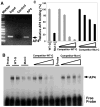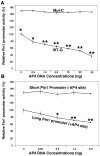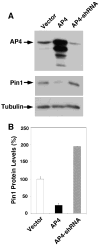A PIN1 polymorphism that prevents its suppression by AP4 associates with delayed onset of Alzheimer's disease
- PMID: 20580132
- PMCID: PMC2988914
- DOI: 10.1016/j.neurobiolaging.2010.05.018
A PIN1 polymorphism that prevents its suppression by AP4 associates with delayed onset of Alzheimer's disease
Abstract
Alzheimer's disease (AD), the most common form of dementia, is characterized by the presence of neurofibrillary tangles composed of tau and senile plaques of amyloid-beta peptides (Aβ) derived from amyloid precursor protein (APP). Pin1 is a unique prolyl isomerase that has been shown to protect against age-dependent neurodegeneration by acting on phosphorylated tau and APP to suppress tangle formation and amyloidogenic APP processing. Here we report a functional polymorphism, rs2287839, in the Pin1 promoter that is significantly associated with a 3-year delay in the average age at onset (AAO) of late-onset AD in a Chinese population. More significantly, the Pin1 polymorphism rs2287839 is located within the consensus binding motif for the brain-selective transcription factor, AP4 (CAGCTG) and almost completely abolishes the ability of AP4 to bind and suppress the Pin1 promoter, as shown by chromatin immunoprecipitation, electrophoretic mobility shift assay, and promoter luciferase assay. Moreover, overexpression or knockdown of AP4 resulted in an 80% reduction or 2-fold increase in endogenous Pin1 levels, respectively. Thus, AP4 is a novel transcriptional repressor of Pin1 expression and the Pin1 promoter single nucleotide polymorphism (SNP) identified in this study that prevents such suppression is associated with delayed onset of AD. These results indicate that regulation of Pin1 by AP4 plays a critical role in determining age at onset of AD and might be a novel therapeutic target to delay the onset of AD.
Copyright © 2012 Elsevier Inc. All rights reserved.
Figures




Similar articles
-
The prolyl isomerase Pin1 regulates amyloid precursor protein processing and amyloid-beta production.Nature. 2006 Mar 23;440(7083):528-34. doi: 10.1038/nature04543. Nature. 2006. PMID: 16554819
-
Association studies between common variants in prolyl isomerase Pin1 and the risk for late-onset Alzheimer's disease.Neurosci Lett. 2007 May 23;419(1):15-7. doi: 10.1016/j.neulet.2007.03.071. Epub 2007 Apr 13. Neurosci Lett. 2007. PMID: 17482359 Free PMC article.
-
DNA sequence variations in the prolyl isomerase Pin1 gene and Alzheimer's disease.Neurosci Lett. 2005 Dec 2;389(2):66-70. doi: 10.1016/j.neulet.2005.07.027. Neurosci Lett. 2005. PMID: 16095818
-
Pin1 in Alzheimer's disease: multiple substrates, one regulatory mechanism?Biochim Biophys Acta. 2007 Apr;1772(4):422-9. doi: 10.1016/j.bbadis.2007.01.006. Epub 2007 Jan 23. Biochim Biophys Acta. 2007. PMID: 17317113 Free PMC article. Review.
-
Cancer and Alzheimer's disease inverse relationship: an age-associated diverging derailment of shared pathways.Mol Psychiatry. 2021 Jan;26(1):280-295. doi: 10.1038/s41380-020-0760-2. Epub 2020 May 7. Mol Psychiatry. 2021. PMID: 32382138 Review.
Cited by
-
The competing risk of death and selective survival cannot fully explain the inverse cancer-dementia association.Alzheimers Dement. 2020 Dec;16(12):1696-1703. doi: 10.1002/alz.12168. Epub 2020 Sep 3. Alzheimers Dement. 2020. PMID: 32881307 Free PMC article.
-
Prolyl isomerase Pin1 in cancer.Cell Res. 2014 Sep;24(9):1033-49. doi: 10.1038/cr.2014.109. Epub 2014 Aug 15. Cell Res. 2014. PMID: 25124924 Free PMC article. Review.
-
Polymorphism rs2327430 in TCF21 predicts the risk and prognosis of gastric cancer by affecting the binding between TFAP2A and TCF21.Cancer Cell Int. 2024 May 7;24(1):159. doi: 10.1186/s12935-024-03343-z. Cancer Cell Int. 2024. PMID: 38714991 Free PMC article.
-
Prolyl isomerase Pin1 as a molecular switch to determine the fate of phosphoproteins.Trends Biochem Sci. 2011 Oct;36(10):501-14. doi: 10.1016/j.tibs.2011.07.001. Epub 2011 Aug 17. Trends Biochem Sci. 2011. PMID: 21852138 Free PMC article. Review.
-
Rate of Memory Change Before and After Cancer Diagnosis.JAMA Netw Open. 2019 Jun 5;2(6):e196160. doi: 10.1001/jamanetworkopen.2019.6160. JAMA Netw Open. 2019. PMID: 31225893 Free PMC article.
References
-
- Bertram L, Lange C, Mullin K, Parkinson M, Hsiao M, Hogan MF, Schjeide BM, Hooli B, Divito J, Ionita I, Jiang H, Laird N, Moscarillo T, Ohlsen KL, Elliott K, Wang X, Hu-Lince D, Ryder M, Murphy A, Wagner SL, Blacker D, Becker KD, Tanzi RE. Genome-wide association analysis reveals putative Alzheimer’s disease susceptibility loci in addition to APOE. Am J Hum Genet. 2008;83(5):623–632. - PMC - PubMed
-
- Brouwers N, Sleegers K, Van Broeckhoven C. Molecular genetics of Alzheimer’s disease: an update. Ann Med. 2008;40(8):562–583. - PubMed
Publication types
MeSH terms
Substances
Grants and funding
LinkOut - more resources
Full Text Sources
Other Literature Sources
Medical
Miscellaneous

